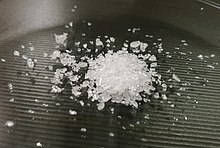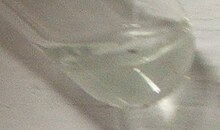
| |||
| |||
| Names | |||
|---|---|---|---|
| Preferred IUPAC name Antimony trichloride | |||
| Systematic IUPAC name Trichlorostibane | |||
| Other names Antimony(III) chloride, Butter of antimony, Antimonous chloride, Stibous chloride, Trichlorostibine | |||
| Identifiers | |||
| CAS Number | |||
| 3D model (JSmol) | |||
| ChEBI | |||
| ChemSpider | |||
| ECHA InfoCard | 100.030.031 | ||
| EC Number |
| ||
| KEGG | |||
| MeSH | Antimony+trichloride | ||
| PubChem CID | |||
| RTECS number |
| ||
| UNII | |||
| UN number | 1733 | ||
| CompTox Dashboard (EPA) | |||
InChI
| |||
SMILES
| |||
| Properties | |||
| Chemical formula | Cl3Sb | ||
| Molar mass | 228.11 g·mol | ||
| Appearance | Colorless solid, very hygroscopic | ||
| Odor | Sharp, pungent | ||
| Density | 3.14 g/cm (25 °C) 2.51 g/cm (150 °C) | ||
| Melting point | 73.4 °C (164.1 °F; 346.5 K) | ||
| Boiling point | 223.5 °C (434.3 °F; 496.6 K) | ||
| Solubility in water | 601.1 g/100 ml (0 °C) 985.1 g/100 mL (25 °C) 1.357 kg/100 mL (40 °C) | ||
| Solubility | Soluble in acetone, ethanol, CH2Cl2, phenyls, ether, dioxane, CS2, CCl4, CHCl3, cyclohexane, selenium(IV) oxychloride Insoluble in pyridine, quinoline, organic bases | ||
| Solubility in acetic acid | 143.9 g/100 g (0 °C) 205.8 g/100 g (10 °C) 440.5 g/100 g (25 °C) 693.7 g/100 g (45 °C) | ||
| Solubility in acetone | 537.6 g/100 g (18 °C) | ||
| Solubility in benzoyl chloride | 139.2 g/100 g (15 °C) 169.5 g/100 g (25 °C) 2.76 kg/100 g (70 °C) | ||
| Solubility in hydrochloric acid | 20 °C: 8.954 g/ g (4.63% w/w) 8.576 g/ g (14.4% w/w) 7.898 g/ g (36.7% w/w) | ||
| Solubility in p-Cymene | 69.5 g/100 g (-3.5 °C) 85.5 g/100 g (10 °C) 150 g/100 g (30 °C) 2.17 kg/100 g (70 °C) | ||
| Vapor pressure | 13.33 Pa (18.1 °C) 0.15 kPa (50 °C) 2.6 kPa (100 °C) | ||
| Magnetic susceptibility (χ) | -86.7·10 cm/mol | ||
| Refractive index (nD) | 1.46 | ||
| Structure | |||
| Crystal structure | Orthorhombic | ||
| Dipole moment | 3.93 D (20 °C) | ||
| Thermochemistry | |||
| Heat capacity (C) | 183.3 J/mol·K | ||
| Std molar entropy (S298) |
110.5 J/mol·K | ||
| Std enthalpy of formation (ΔfH298) |
-381.2 kJ/mol | ||
| Gibbs free energy (ΔfG) | -322.5 kJ/mol | ||
| Hazards | |||
| GHS labelling: | |||
| Pictograms |  
| ||
| Signal word | Danger | ||
| Hazard statements | H314, H411 | ||
| Precautionary statements | P273, P280, P305+P351+P338, P310 | ||
| NFPA 704 (fire diamond) |
 | ||
| Flash point | Non-flammable | ||
| Lethal dose or concentration (LD, LC): | |||
| LD50 (median dose) | 525 mg/kg (oral, rat) | ||
| NIOSH (US health exposure limits): | |||
| PEL (Permissible) | TWA 0.5 mg/m (as Sb) | ||
| REL (Recommended) | TWA 0.5 mg/m (as Sb) | ||
| Safety data sheet (SDS) | ICSC 1224 | ||
| Related compounds | |||
| Other anions | Antimony trifluoride Antimony tribromide Antimony triiodide | ||
| Other cations | Nitrogen trichloride Phosphorus trichloride Arsenic trichloride Bismuth chloride | ||
| Related compounds | Antimony pentachloride | ||
| Except where otherwise noted, data are given for materials in their standard state (at 25 °C , 100 kPa).
| |||
Antimony trichloride is the chemical compound with the formula SbCl3. It is a soft colorless solid with a pungent odor and was known to alchemists as butter of antimony.
Preparation
Antimony trichloride is prepared by reaction of chlorine with antimony, antimony tribromide, antimony trioxide, or antimony trisulfide. It also may be made by treating antimony trioxide with concentrated hydrochloric acid.
Reactions

SbCl3 is readily hydrolysed and samples of SbCl3 must be protected from moisture. With a limited amount of water it forms antimony oxychloride releasing hydrogen chloride:
- SbCl3 + H2O → SbOCl + 2 HCl
With more water it forms Sb
4O
5Cl
2 which on heating to 460° under argon converts to Sb
8O
11Cl
12.
SbCl3 readily forms complexes with halides, but the stoichiometries are not a good guide to the composition; for example, the (C
5H
5NH)SbCl
4 contains a chain anion with distorted Sb octahedra. Similarly the salt (C
4H
9NH
3)
2SbCl
5 contains a polymeric anion of composition
n with distorted octahedral Sb.
With nitrogen donor ligands, L, complexes with a stereochemically active lone-pair are formed, for example Ψ-trigonal bipyramidal LSbCl3 and Ψ-octahedral L
2SbCl
3.
While SbCl3 is only a weak Lewis base, some complexes, such as the carbonyl complexes Fe(CO)
3(SbCl
3)
2 and Ni(CO)
3SbCl
3, are known.
Structure
In the gas phase SbCl3 is pyramidal with a Cl-Sb-Cl angle of 97.2° and a bond length of 233 pm. In SbCl3 each Sb has three Cl atoms at 234 pm showing the persistence of the molecular SbCl3 unit, however there are a further five neighboring Cl atoms, two at 346 pm, one at 361 pm, and two at 374 pm. These eight atoms can be considered as forming a bicapped trigonal prism. These distances can be contrasted with BiCl3 which has three near neighbors at 250 pm, with two at 324 pm, and three at a mean of 336 pm. The point to note here is that the all eight close neighbours of Bi are closer than the eight closest neighbours of Sb, demonstrating the tendency for Bi to adopt higher coordination numbers.
Uses
SbCl3 is a reagent for detecting vitamin A and related carotenoids in the Carr-Price test. The antimony trichloride reacts with the carotenoid to form a blue complex that can be measured by colorimetry.
Antimony trichloride has also been used as an adulterant to enhance the louche effect in absinthe. It has been used in the past to dissolve and remove horn buds from calves without having to cut them off.
It is also used as a catalyst for polymerization, hydrocracking, and chlorination reactions; as a mordant; and in the production of other antimony salts. Its solution is used as an analytical reagent for chloral, aromatics, and vitamin A. It has a very potential use as a Lewis acid catalyst in synthetic organic transformation.
A solution of antimony trichloride in liquid hydrogen sulfide is a good conductor, though the applications of such are limited by the very low temperature or high pressure required for hydrogen sulfide to be liquid.
References in popular culture
In episode 2 of the third season of the popular British program All Creatures Great and Small (adapted from chapter six of the book All Things Wise and Wonderful), several calves died at Kate Billings farm following an episode of nonspecific gastroenteritis, the cause of which was later determined to be ingestion of antimony trichloride present in a topical "butter of antimony" solution painted on to cauterize and remove their horn buds.
References
- ^ "Antimony Trichloride, SbCl3".
- ^ Seidell, Atherton; Linke, William F. (1952). Solubilities of Inorganic and Organic Compounds. Van Nostrand.
- ^ "Antimony(III) chloride".
- Antimony trichloride in Linstrom, Peter J.; Mallard, William G. (eds.); NIST Chemistry WebBook, NIST Standard Reference Database Number 69, National Institute of Standards and Technology, Gaithersburg (MD) (retrieved 2014-05-28)
- ^ Sigma-Aldrich Co., Antimony(III) chloride. Retrieved on 2014-05-29.
- ^ NIOSH Pocket Guide to Chemical Hazards. "#0036". National Institute for Occupational Safety and Health (NIOSH).
- ^ Greenwood, Norman N.; Earnshaw, Alan (1984). Chemistry of the Elements. Oxford: Pergamon Press. pp. 558–571. ISBN 978-0-08-022057-4.
- Zarychta, B.; Zaleski, J. "Phase transitions mechanism and distortion of SbCl
6 octahedra in bis(n-butylammonium) pentachloroantimonate(III) (C
4H
9NH
3)
2". Z. Naturforsch. B 2006, 61, 1101–1109. Abstract (PDF) - ^ "Antimony: Inorganic Chemistry" R. Bruce King Encyclopedia of Inorganic Chemistry Editor R Bruce King (1994) John Wiley and Sons ISBN 0-471-93620-0
- ^ Wells A.F. (1984) Structural Inorganic Chemistry 5th edition, pp. 879 - 884, Oxford Science Publications, ISBN 0-19-855370-6
- Patnaik, P. Handbook of Inorganic Chemicals. McGraw-Hill, 2002, ISBN 0-07-049439-8.
- Wilkinson, John A. (1931). "Liquid Hydrogen Sulfide as a Reaction Medium". Chemical Reviews. 8 (2): 237–250. doi:10.1021/cr60030a005. ISSN 0009-2665.
| Antimony compounds | |||
|---|---|---|---|
| Antimonides | |||
| Sb(III) |
| ||
| Sb(III,V) | |||
| Sb(V) |
| ||

